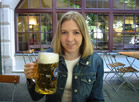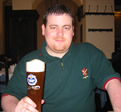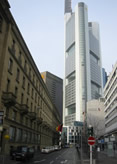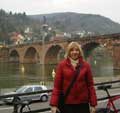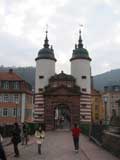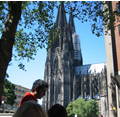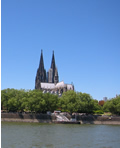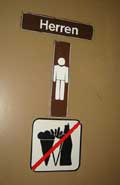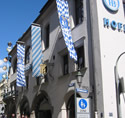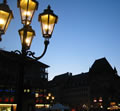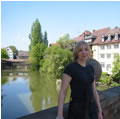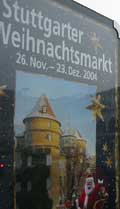| How would you like to view this page? | ||
|
Jump To:
See Also:
Selected Non TA Photos:
|
(Based on trips to Ahlen in December 2006, Berlin in October 2005 and April/July/August 2007, Bremen in April 1999 and May 2003, Dortmund in Sept 2003 and June/Dec 2006, Düsseldorf in July 2002 and throughout 2005 and 2006, Emden and Essen in Sept 2006, Frankfurt in Dec 2002 and Dec 2004, Mainz in December 2002, Hamburg in September 2003 and February/Nov 2006, Hannover in June 2005, Munich in May/Sept 2003, June 2004 and July/Oct 2005, Köln in November 2004 and June 2005,Leipzig in August 2006, Osnabrück in December 2005, Heidelberg, Mannheim and Stuttgart in December 2004 and Regensburg in March 2009) |
 |
Germany is one of our favourite destinations. It’s very similar to home (people and weather-wise!), and is a very easy place to be. Contrary to the popular tabloid portrayal of German people, I've always found the locals to be very polite, friendly and humorous (I should probably also point out that I do most of my interacting in pubs, where the friendliness and humour levels do rise in relation to alcohol intake), which brings us on to… The beer! German beer is rightly heralded as some of the best beer in the world (along with Czech and Belgian), and for me (and many fellow connoisseurs) is reason enough to visit the country in the first place. The beer comes in several types, the main ones being: Pilsner (what we commonly associate with German beer, even though it is Czech in origin), Helles (the most common), Weissbier (like Hoegaarden, but less sweet and fruity), Dunkel (dark beer, similar to old-fashioned stout, achieved through roasting the hops) and Altbier (a Düsseldorf specialty, like a cross between keg bitter and lager, but far nicer than it sounds!). If you want more information, check out the British Guide to German Beer, the Beer Section of Travels Through Germany and this excellent pan-European pub guide site. There are different places to get fed in Germany, and again these are very similar to home: restaurants (of varying degrees of posh-ness), beer halls/gardens/bars (some of the Hausbraueries have great menus, including beer-cooking), and take-aways (commonly known as “imbiss”) – all of these cater for vegetarians better than almost anywhere else in Europe. Personally I lean towards the pub grub, although the imbiss can provide some superb snacks, and have a far better reputation than most of the salmonella dens we have to suffer at home! Recently, since denouncing vegetarianism, I've developed a hankering for the ubiquitous sausage - try it yourself, after all... what's the würst that could happen? If you get the chance, then try to visit Germany in the run-up to Christmas. Almost every town has a Christmas Market (Weihnachtsmarkt), and larger cities often have several. This is an exercise in kitsch-ness, with stall after stall of decorations, chocolates, food and the excellent gluhwein (hot mulled wine - head for the busiest stall - if the locals like it, it must be good). One thing to bear in mind with Germany, as in most of Europe, are restrictive Sunday opening hours affecting shops (that don’t open until 10am on weekdays, and close early on Saturdays!). Also: don’t cross roads without waiting for the green man, or you will incur the wrath of all locals; look out for cyclists – the funny bit on the edge of the pavement will inevitably be a cycle lane; and include your tip with your bill (don’t just leave it on the bar). |
|
|
Having been here once before and only finding a pizzeria for a beer (for a Scotland U21 game in 2003), we didn’t hold out much hope. As it happens, heading the opposite way from the station leads to a small, pedestrianised town centre, bookended by a couple of very drinkable pubs. Gastatte Strickmann is on the corner of Oststrasse and the road leading up from the station and serves both Pils and a local version of Alt. Tables for eating abound. At the other end of the precinct, Alter Hof and Kirchplatz have another couple of options. The party pub on the northern side of Kirchplatz offers a range of local Potts beers and was very friendly. There was also a nice looking pub in the station itself, but by the time we got back there, we were in no real state to sample their hospitality! |
||
Berlin was built up to be a real city of promise before we went, however on my first (and to date, only) visit, I have to admit to finding it a bit London-ish. Then I realised most of the people who’d been raving about it are Scots who moved to London because they love it so much! Maybe it was the unreliable transport system that was constantly affected by weekend railworks, or maybe it was the rudeness of the bar-staff and their insistence on speaking English from the off despite my attempts to practice my fledgling Deutsch, but the reliability and friendliness we’ve come to associate with most German cities wasn’t as forthcoming. Anyway, despite this, it’s certainly not a lost cause. Everyone said “stay in Mitte”, but as second trip (which should have been in December 2005 for the markets) was based there, we opted for the Ku’Damm instead. This was a mistake – stay in Mitte! The only good things the Ku’Damm had goimg for it was the proximity to the Hauptbahnhof, the bombed out church and the excellent Hanne Am Zoo football bar. There is loads to do in Berlin, from highly-regarded walking tours (and not-so-highly regarded bus ones), to visiting the famous Zoo, to riding high up the Fernsehturm in Alexanderplatz to marvelling at the attempted new “western” city centre in Potsdamer Platz. The Brandenburg Gate and the Checkpoint Charlie museum will also be vying for your attention. Not for us, however – we were there for a football match (played in Dynamo Berlin’s historic old ground in Prenzlauer Berg), and the sights took a back seat. All we did get to see was the restored Nikolaiviertel area off Alexanderplatz, and only then as it was on the way to a pub! The other “sight” we saw, which is cheating a wee bit, is the Olympic Stadium, out in the wooded west of the city and open to the public when not in use – we’d missed the last tour of the day, but you can pay a small entrance fee and just wander around most of the complex yourself. Well worth it for anyone interested in football, the Olympics or Albert Speer’s brutal architecture. As for pubs, we really only scratched the surface, so expect this list to grow with future visits (edit - don't worry, it is!). Berlin is certainly brew-pub heaven, and I when I go back I fully expect to hit them with a vengeance (edit - I have been!). Also, give Berliner Weisse a go if you can – it comes in stubby bottles and is usually taken “mit rot” (with raspberry syrup) or “mit grün” (woodruff), as many people find the sour taste of this weak (2.8% or so – more of a breakfast tipple) beer a little too tart.
Thanks to Steve Thomas' excellent Good Beer Guide Germany (published by Camra) for detailing all of the brewpubs above, enabling us to track down some of the more hidden gems! |
|
|
| Bremen is a beautiful and very under-rated city. Situated in Northern Germany, in it’s very own city-state (the second oldest in the world, after San Marino), it benefits from it’s own international airport, just 20 minutes from the city centre by tram. The station is also an easy walk from the centre. One of the first things you notice is the amount of green space around Am Wall – there’s even a picturesque windmill, and the River Weser leads down to a large park containing the football stadium. Any tour of Bremen should start with the the Schnoor - the old fishing village that still has cobbled streets and olde-worlde shops, before leading up to the Marktplatz, with the Rathaus, a big church, some preserved hanseatic merchant houses, a statue of the Town Musicians (a chicken, a cat, a dog and a donkey) and a terrible 1960s town hall, that ruins the ambience a wee bit! The main shopping area is to the north and west of here, however due south, directly opposite the Rathaus, is a lane that leads to Botcherstrasse, a 1930s exercise in red brick and gilt-plated architecture. If you follow this down and turn right at the end, you can walk along the riverside. Follow this down past all the bars, and turn left over the bridge at the end that passes the end of the island and you will be on the doorstep of my personal highlight – the Beck’s Brewery. Brewery Tours run hourly Tuesday-Saturday, and there is a tour in English at 1.30pm each day; this cost €3 (May 2003), lasted 2 hours, and included a beer taste test and 2 free beers, as well as a chance to peruse the shop. At the brewery you will get the chance to try Haake-Beck, the local, hoppier version of Beck's - make sure you try the "Kräusen", a pils made cloudy due to a gravity-driven "widget" in the barrel. Great places to head for a drink are the river-front, Beck's Am Markt and Beck's Im Schnoor (both quite pricey), Das Viertel ("the quarter"), and Spitzen Gebel, a great wee bar down a lane near Botcherstrasse. Also of note are the two brewery pubs - the Schuttinger, right next to the Ramada-Treff hotel near the Markt, and the Borgfelder Landhaus, a tram and then bus-ride away, but worth it. |
|
|
Now, to be fair, we didn't see the famed Neustadt, to the north of the Altstadt and famously rebuilt, however what we did see (around the Hauptbahnhof and the Rudolf Harbig Stadion) was enough to convince us not to rush back. On the plus side, Dresden does have a London Eye style big wheel near the main station - why not pay an over-inflated entry fee so you can gaze out towards the DDR-style tower block suburbs and truly appreciate what a soul-destroying place this is. Dresden doesn't offer much in the way of immediately welcoming pubs, but what it lacks in drinking venues, it makes up for in spades in the skinhead department. If you do feel the need to run a gauntlet of hate from entire families of locals, then the thugs at the Rudolf Harbig Stadion will be than happy to intimidate, berate and attack you. |
||
Our visit to Dortmund was a fleeting one, and we weren't overly impressed with what we saw - there are certainly prettier German cities. However, the place was very friendly, and this is something that other 8,000 or so Scots in town at the time also commented on. Bar-wise - the bad weather compelled us to only check out a couple of places, but one of them is right up there with the other great German beer halls we've encountered. Hövels Hausbraurei, an easy walk from the City Centre, combines excellent beer with superb food, and is well worth a lengthy visit. We stayed in the Gildenhof hotel - way out towards the huge meccano kit that is the Westfalen Stadion. The hotel was fine, but best of all, next-door to a little, friendly locals bar. The whole city is football mad, and there are several well-stocked football shops at the western end of the precinct. Update December 2006: Dampfloek – not bad for a station pub, but not great either. To be found out of the main door, sharp right and in the parade of travel agent shops. Pub in station – possibly called City Treff, this is more your typical station boozer, complete with separate toilet accessed with a key kept behind the bar. Notable for offering Hövels bitterbier on draught. If you’re in Dortmund in the month leading up to Christmas,
be sure to allow some time to head to the Christmas Market. The
main market square boasts the world’s biggest Christmas tree
(of “Tannenbaum” in German), clocking in at an impressive
80m. To put this in perspective, we could see the star on the tree
from our hotel room window, and that was from 700m away and with
a seven-storey building in the way. |
|
|
(NOTE: this is only part of the story! For a 7-page downloadable PDF file, complete with maps, click here) What to say about Düsseldorf? One of my favourite cities - definitely the best drinking destination in Europe. Düsseldorf's Altstadt has a reputation as the "longest bar in Europe" - not one bar, but hundreds of them (none of which are individually very long). The place is driven by the love of a beer called "Alt", a sort of cross between bitter and lager (much nicer than it sounds!). It's not all about the bevvy, mind. The Konigsallee is one of Germany's most famous designer shopping streets, he Rhine flows through the city, giving ample riverside space for walks, parks and riverside summer terrace bars, and the TV Tower sports a nice revolving restaurant, giving views over the altstadt, the modern architecture of the Media Harbour, and even as far as Cologne’s own TV Tower. The "Mediahafen", with it's trio of Frank Gehry buildings, is well worth closer investigation if you've any interest in architecture. A few of my favourite pubs include:
|
|
|
"Moin Moin" - East Friesland's traditional greeting takes a little getting used to, but you will hear it in this very friendly and quaint town in a far corner of Germany that tourists rarely venture into. Stuck in the extreme north-west of Germany (Bremen is the nearest airport, at over 100km away), it is very Dutch in it's ambience. By all accounts, there are a few museums, as well as opportunities to take harbour cruises and boats further afield to the East Friesian Islands, but we were in town for less than 24 hours (to see Fortuna play Kickers Emden), so it's mostly pubs. There's a wee tourist office at the station, which is on the western edge of the centre. Pils is the beer of choice, and is served in 0.2l measures as standard.
|
||
Essen may be a hard city to love, with the ghost of heavy industry weighing heavy upon it, replaced in part by a shopping empire, but it's also a hard city to dislike. The entire place is extermely welcoming to outsiders, particularly in view of the fact my two fleeting visits have been for football. There are some attractions, such as Villa Hugel, Zolle Zollervein and the olde worlde suburb of Werden, but I've never seen them. What I have seen is a few pubs and the football team, Rot Weiss Essen, who despite being local rivals of Fortuna, have incredibly friendly and fun supporters.
|
||
Frankfurt is a much-maligned place, criticised for just being a boring concrete jungle populated by financiers. When you explore the Apfelwien taverns and quaint bars of Alt Sachsenhausen, you'll wonder why more people don't know about this city's secrets. Served by the massive international airport, which has excellent S-Bahn links to the city, Frankfurt is a doddle to get to. Both the airport and the city stations are major rail hubs within Germany. The area around the station can be a wee bit shady, although many of the budget hotel options are around here - try and get something in Sachsenhausen if you can (or near the zoo as a second choice), as this is where you'll most likely be doing your socialising. Frankfurt's main attractions are the shopping and the zoo - although when we went we couldn't find the monkeys! An excellent way to get to grips with the place is to hop on the Ebbelwoi Express - this is a camply-coloured tram that does a circular route from the zoo around the town. Included in the price is a bottle of Apfelwein (not as good as the fresh stuff) or Apfelsaft. The Altstadt has been well-reconstructed since the war, but pretty as it is, it lacks a certain buzz. Bizarrely, the airport itself is also quite a draw. The best drinking options are pretty much centred around Sachsenhausen. Apfelwein (a tart cider-like drink), also known locally as Ebbelwoi, is best sampled in an authentic tavern - you'll find a number these are clustered along Textorstrasse (near Lokalbanhof station) and Schweizer Strasse- you can tell if a tavern has new wine on sale by the wreath on the door. Don't miss the chance to take your Apfelwein with "handkase mit musik" - literally hand cheese with music: the music comes later after the onions have kicked in! There is a cobbled triangle of streets between the Alte Brucke and Obermainbrucke bridges that makes up the beating bar-land heart of Alt Sachsenhausen - look out for the one on the corner ran by an ageing punk who gets all his pals singing along. My favourite bar in all of Frankfurt is a few minutes away from here, down a dark street called Dreikonigstrasse (near a big church) - called Balalaika, it's owned by an American blues singer called Anita. Very small and smoky, with only around 6 tables - you may even be treated to a live performance by the owner - a must-see bar. If you are reluctant to wander out of the small altstadt then try the Weinstube on the western edge, or the one facing (near the U-Bahn). Finally, if you really must, there is an ex-pat magnet of a huge Irish pub right opposite the main train station. All in all, Frankfurt's a wee bit like Dr Pepper... try it, you might like it! |
|
|
A very vibrant, and very "alive" city, with more than an undercurrent of seediness. On our first visit we stayed near the St Pauli landing, just a couple of streets off the tacky neon pleasure-park that is the Reeperbahn; visit two was on the Reeperbahn itself in the Ibis. St Pauli's Millentor stadium is well-worth a visit. The club are showing signs of losing their alternative tag, ironically by marketing it ("Not established since 1910" is the new club motto), but you can still buy cool skull & crossbones hooded tops in the club shop, and enjoy a cool beer in the Clubheim bar (when it's open). Hamburg's ground, the futuristic AOL Arena, is well out of town but the 90 minute tour (only in German) is well recommended, although you may want to try and take in an Altona '93 game - apparently this where some of the orignal St Pauli punks have deserted to. The back-streets between the Millentor and the Reeperbahn are fertile for small pubs and bars, although the Reeperbahn itself is very, very touristy, with prices to match. There can also be a slightly menacing atmosphere, as scores of shore-leave sailors and drunken Germans from near and far roam the streets for beer and other ways to spend their hard-earned. For a more soulful experience, take in the stunning interior of St Michelius (the "Michel"), northern Germany's flagship Protestant church (not that it has much to do with fire and brimstone). I'd recommend a harbour cruise - the Elbe river is very busy and the docks are surprisingly interesting. Walk along the St Pauli landing and you'll be spoilt for choice. If you want to cruise through the narrow canals, you'll need to go for one of the smaller wooden boats. We didn't have too much time, so went for a open-top bus tour as well - this did give us a glimpse of the Altstadt and the posh area around the Alster lakes. The following pubs are worth tracking down (some more than others, mind!):
|
|
|
Heidelberg is a real tourist favourite, and as one guide book warns, it will feel as though they are still there when you are. Busloads of camera-toting American and Japanese tourists mingle in the streets with the privileged students (Heidelberg is the equivalent of Cambridge). Whilst the area around the station (and the very handy Ibis hotel) is pretty depressing, despite the modern art of the print house building, the altstadt is stunning and authentic, having successfully avoided most of the bombing in the war. The same cannot be said for the ruined Schloss perched above the old town - the castle has been in ruins for since Louis someone-or-other kicked off in the middle ages, but tours are still available, including the largest wine barrel in the world (with it's own dance floor on top). There is a lot to do in Heidelberg - enough to fill a couple of days - but the summer offers more options along the river and the famous "Philosophers Way" footpath. Of course, it also offers hordes of tourists too, which is why you our early-December midweek visit was so peaceful. If you're looking for the Christmas markets, don't fall into the trap of thinking the stalls clustered around the cathedral and adjoining Kornmarkt square are your lot: the main action can be found further down the precinct in the University Square. The old town offers the greatest selection of eating and drinking options. In particular, three brew-pubs are very highly recommended: the Kulurbrauerei offers a great range of beer (including a variety of Kräusen) in a swish high-ceilinged setting, whilst the much older Vetter boasts a similarly impressive range (which you can ask for in 1 litre mass glasses), as well as the "strongest beer in the world", a tar-like substance that clocks in at 33% (and is mercifully only served in 2cl glasses). The third, Palmbräu Gasse, can be found straddling the main precinct and the small street behind renowned for drinking options, and serves up a very good altbier (amongst others) in stoneware mugs. Other notable pubs in the altstadt area are the olde-worlde neighbouring student pubs of Zum Sepp'l - a dark place covered in centuries old graffitti - and our favourite, Zum Roten Ochsen ("The Red Ox"), a real treasure trove of good food, beer and wine (some of which is available in large boot shaped glasses). When we were in, we had the good fortune to share a few beers with the landlord and landlady (Phillip and Ann - it's been in the family for around 150 years), and were shown a signed photo of Mark Twain that adorns the wall. Finally, a good fun option is the eclectic Ecksteins, complete with magician owner and full-stocked DJ booth. Heidelberg is well worth a visit, but be prepared for the tourist/student onslaught. Perhaps best visited during the week and out of season (as we did) if you do want to avoid the crowds. |
|
|
I warn you now, I’ve only spent one night in Hannover (June 2005 for a Confederations Cup match), and I wasn’t too impressed – it left me with a similar impression to Stuttgart; not great at first, but I’m sure it would grow on me. The town was decimated by war, and aside from a small reconstructed altstadt, much of the city is post-war parkland and lakes – the large park and Machsee to the south of the centre (allow at least 25 minutes walk) is where the massive bowl of the Niedersachsenstadion can be found. The station is in a depressing part of town, as was our hotel – facing the neon red-light district. When it comes to nightlife, the city’s shining beacon is the huge Brauhaus Ernst August, open for breakfast all year at 8am, and open late almost every night with some kind of entertainment. Other bars are clustered to the north-west of the main church (including the quirky, subterranean Weinloch), and on the street facing the Opera House. There may be museums and other attractions (the curved elevator in the town hall’s domed roof is famous), but we didn’t have time to see them. It might not be the best city in Germany, but it is served by direct
BA flights from Gatwick and is a handy staging post for Bremen and
Hamburg (both slightly over an hour away by regular fast trains). |
|
|
Köln really is a tourist mecca, with busloads heading for the rightly-famous, incredibly imposing Dom. If you're here, you really should make the effort to see it. The altstadt, leading south from the Dom, is also very pleasant, and the Belgisches Viertel (Belgian Quarter) hosts a number of popular nightlife options. Köln/Bonn airport, halfway between the two cities, used to be one of the primary airports given Bonn's status as West Germany's capital before the re-unification. These days it is building up a brisk trade in budget airlines, with GermanWings and Easyjet both offering a host of flight options at the time of writing. Köln's Hauptbahnhof is literally in the shadow of the cathedral, and is reached from the airport via a new S-Bahn link that goes over the historic and iconic metal bridge over the Rhine. The city lies to the south of the mass of cities that make up the Ruhrgebiet, and has S-Bhan links all the way up to local rival Düsseldorf, as well as fast train links all over Germany. The rivalry between Köln and Düsseldorf is best summed up by their local beer styles, both of which are drank in tiny 2cl glasses. Whilst Düsseldorf's altbier is dark and earthy, and comes in no-nonsense squat glasses, Kölsch (the same name as Köln's local dialect) comes in fluted glasses called Stangen ("sticks") and is a pale, dry and slightly weaker (4%) lager-based effort. It takes some getting used to, and certainly isn't universally popular with the rest of Germany. Pick of the sights:
Traditional beer in Cologne is called Kolsch, and is a slightly bitter dry lager, and the best best place to try it are the brewery pubs around the town. My favourite types are Fruh, Paffgen, Muhlen (all these three have great brew-pubs in town) and Reissdorf (known as a "ladies" beer as its the sweetest!), I've never eaten in a restaurant in Cologne as the brew-pubs do such good food. A lot of other bars don't do much in the way of food. Try a "Halven Hahn" for a snack - means "half chicken" but is actually a crusty roll, a big lump of cheese and mustard (sometimes already sitting in a pot on the table). Round up to the next nearest Euro or so for a tip (even for beers). In addition to the altstadt, where pubs cluster around the altermarkt, the buttermarkt, heumarkt and the streets linking the three, the Belgian Quarter is an excellent place to head for nightlife - a number of German pubs, music bars and Irish pubs jostle for space along Friesenstrasse, whilst right around the corner the Aquarium cocktail bar knocks out all the usual trimmings, plus a few Kölsch specialities (the Kölsch Colada was my favourite). In the centre, aside from brew-pubs, is an excellent and very quirky bar in the Alter Markt called Papa Joe's Biersalon, complete with life-sized hydraulic organist and trombonist controlled by a jukebox of sorts. Cologne is rammed with Irish pubs. Never been in one (no need with so many other places), but there are a couple of very popular ones facing each other across the Alter Markt, as well as Barney Valley's, which is right next to...
|
|
|
Grim as Dresden may be, Leipzig offers much more to the weekend visitor, although it still compares badly with almost all major cities in the west of the country. One thing it does boast is the biggest rail passenger terminal in Europe, and it is a beauty; complete with a three floor, 180+ shopping mall (which strangely, doesn't seem to boast a normal supermarket!). The space-age Zentralstadion was built for the 2006 World Cup, and amazingly sits inside the grassed over bowl of the old 100,000 capacity stadium - well worth a visit if Sachsen Leipzig are at home. Other highlights are the "old time" bus tours, the massive Napoleonic War monument and Dante's favourite restaurant, Auerbachs Keller (where Faust dined with the Devil), but be warned, the local softly spoken dialect can be incredibly hard to decipher. On the pub front, the following are highly recommended:
|
||
Mainz is on Frankfurt's doorstep, but is actually in a different province: Rhineland-Palatinate. Small, and pretty manageable on foot, Mainz (pronounced "Mines") is small, pleasant and manageable on foot. The town centre is on the pedestrianised Liebfrauenplatz, and when we were there (December 2002) the Christmas market was in full flow. Just across from the main square is the ancient Dom, dating back from the year 1000. Mainz is very much a wine town, and there is an excellent wine bar just up from the Liebfrauenplatz (stand with your back to the Dom and head down the right hand side), although there is an excellent brewery pub on Weissliliengasse called the Eisgrub Brauhaus. Here you can ask for a "metre of beer" (helles or dunkels, or half of each), which is a spanking paddle with 12 glasses on - the food came highly recommended too. |
|
|
The Lonely Planet warned us that Mannheim was unlikely to make it into any Top 100 of German cities, and I have to concur. Despite the chess-board centre lay out and the depressing grey post-war industrial architecture, it's not all bad... the beer's good, and the slightly mature Croatian barmaid is stunning! The station is at one corner of the grid that composes Mannheim's soul-destroying centre - straight out of the station on the right hand side is an Irish Pub (Murphy's Law) where you would expect to see a furniture showroom. The pub itself was friendly enough (and there's another one over the road and round the first corner on the left), but for proper German beer near the station, try the Schmuckerstube, a tiny bar serving Schmucker beers (complete with framed Windows 95 clip art graphics on the wall). There is a brew-pub in Mannheim to the north, over the river (try and avoid heading west over the other river - that takes you to Ludwigshafen, a suburb-city with a fearsome reputation), but it was too far out for us to try and find. Instead, we opted for the excellent Alter Simpl, a bar/restaurant on the ground floor of a hotel in the centre. Another excellent bar, featuring an impressive array of Bundesliga stickers amonst other assored tat, and an excitable (and exciting - look at the photos on the wall!) Croatian barmaid, can be found in the side street opposite the Kaufhof department store. I honestly don't know if there are any sights in Mannheim - we were only there for the day of the Scotland future team game - but I understand most people choose to head 20 minutes down the road to Heidelberg. |
|
|
| A lot was expected of Munich, but personally I was a wee bit disappointed, as it failed to live up to my expectations. In particular, I was a wee bit sad that the beer was not as great as I had been led to believe, with only Tegernsee and Hofbrauhaus beer as good as I had hoped. We arrived late on our first visit, and struggled to find an open bar - the sheer size of Munich means that the nightlife areas are spread out, and we were obviously looking in the wrong places! The city centre is big, yet walkable, and contains several sights, including the Rathaus and the Marienplatz, centred on a long pedestrianised street. The Hofbrauhaus is situated just to the north of here, and is well worth a visit, even if it is a kind of theme park for tourists! The Ayinger bar opposite the Hofbrauhaus’ front door is also well worth a stop. Munich Zoo is well-regarded as one of the best in Europe, however for me a must-see was a visit to the Olympiastadion. We went on the football and stadium tour at 11am, and were lucky enough to see the workmen taking down all the Bayern decor and replacing it with 1860 Munich photos - a job that happens every week. The Olympia Tower is also well worth a visit, but beware that queues for the lift are not uncommon. A futuristic, bubble-wrapped grey blob on the northern outskirts is actually the Allianz Arena, the new home to Bayern and 1860 and the venue for the WC2006 opening ceremony. The looonnng path from Fröttmanning U-Bahn station curves around so the stadium remains centre stage, and an entire industry servicing the ground on non-matchdays has already sprung up, including a mini shopping mall on the second level with 1860 and Bayern megastores, an Audi showroom and a technology shop. The tour is okay, but was solely in German, and apart from the a la carte restaurant (which we didn’t venture into), there’s nowhere to go for a beer. As I'm not one for crowds, I have no intention of ever making it to the Oktoberfest, however whilst we were there the first time the Frühlingfest (Spring Fest) was on at the same site (although only using around a third of the space). The experience was slightly frustrating, as getting a seat (which you need in order to get served) can be quite a daunting task - when we did, we ended up in conversation with some German-speaking Poles. Armed with a copy of the excellent "Beer Drinkers Guide to Munich" (by Larry Hawthorne, Freizeit Publishers), we managed to get to a host of bierkellers and beer halls, enabling us to get a taste of the "Big Six" - Augustiner-Brau, Hacker-Pschorr Brau, Hofbrauhaus, Lowenbrau, Paulanerbrau and Spatenbrau. If you like your beer, I'd really recommend getting hold of a copy of this book. If micro-brewery beer is your bag, Airbrau at the airport comes very highly recommended. Isarbrau, down in the outskirts (in the old Grosshesselhoe S-Bahn building) is very good beer but quite a restaurant type place at weekends, and the Paulaner Brauhaus at Kapuziner Platz brews the revived Thomasbrau in a very nice setting. Food-wise, you won't go short of choice, but we stuck to beer hall food and weren't disappointed. In particular, Kartoffelsalat (potato salad) and Kartoffelsuppe are Munich favourites with beer. The Schwabing area is very popular, and has a number of student bars and clubs, but we never made it out that far. The area around the station has a mini-red light district, but also has "Bar 55", a football fans favourite, although it's a bit small and poky. The Hofbrauhaus has to be tried (great beer, but very touristy), and there is a cluster of other pubs around, including a terrible Irish pub (the Galway Hooker) and The Landhaus, a great wee pub with a tree at one end of the bar (opposite the Mandarin Oriental hotel). My favourite beer hall is the Löwenbraükellar on the corner of the massive brewery, just one U-Bahn stop north of the main station, although the Hofrbraukeller is also great in warm weather – its beer garden holds thousands! The easiest way to get there is U-Bahn to Max Weber Platz, which is also the site of the excellent Unionsbraü brauhaus. Finally, four key pieces of key drinking information:
|
|
|
Bavaria’s second city might not have the same buzz, or the hordes of Japanese tourists, that Munich has, but it has a far quainter and more tranquil feel to its city centre. A lot of the city survived the bombing raids, and the bits that didn’t were fully restored using the characteristic pinkish stone that gives the city such a subtle hue at dusk. The medieval Altstadt is still ringed by its original walls, and is much larger than most German cities; split in half by the river, the southern side contains the shopping precincts, whilst the hillier northern side has the main square and the city hall, as well as some of the quainter, authentic drinking holes. There’s a lot to do and see, museum and sight-wise, and it may be worth investing in a Nuremberg Card from Tourist Info or your hotel (works as a travel pass too). Not one for museums myself, even I couldn’t resist the Star Wars figure exhibition at the Altstadt’s Spielzeugmuseum (Toy Museum). There’s also a Train Museum, but that was closed when we were there. You can escape the tourist crowds by heading underground – the town hall has its own dungeons, complete with torture chamber (again, shut when we were there), and the old city cellars, the “Felsengänge”, can also be toured, conveniently finishing up at the Altstadthof brewery. The recent past is not airbrushed over either – some of the old “parade grounds” still stand in the south-east of the city (Tram xx or Bus 36 to “Doku Zentrum, or S2 to Dutzendriem for the northern edge, or Frankenstadion for the football ground), and the most famous one, the Zeppelin Field, is literally across the street from the Frankenstadion, one of the host stadiums for WC2006. The Kongresshalle, a huge semi-finished horseshoe-shaped building, designed to compare with, and dwarf, Rome’s coliseum, still stands in the north of the grounds. The north-eastern corner houses the Documentation Centre, an excellent exhibition charting the rise and fall of the Nazis, from a German perspective, and is well worth a visit – the tour is by audio-guide, and this can be set to English by the guy selling the tickets. You may even get the chance to take the long climb up to the viewing platform on the roof for an amazing panorama of the parade grounds and the city. Nuremberg is famous for it’s sausages – strict rules govern the ingredients, so no offal is used. They are also much smaller and thinner than the traditional image of bratwurst, but that doesn’t affect the taste. Our favourite sausage place was in the Handwerkhof at Königstor, a medieval recreation at the start of Königsalle opposite the main station. Nightlife in Nuremberg is more sedate than the likes of Munich and Düsseldorf, but that suited us just fine. There are two excellent brew-pubs – the massive cellar of the Malt house on Königsalle hosts Barfüsser, whilst in the northen Altstadt, Alstadthof can be found on Bergstrasse. This excellent brew-pub has three bars (not all are always open), and even does a roaring trade in 1 litre carry out bottles. Try the tasting palette for a small measure of the lager, the black beer, the wheat beer and the red beer, finishing off with a Bockbier schnapps (drawn from the excess alcohol from the brewing process). A few doors up the hill is the functional bar of the Albrecht Dürer Hotel, which boasts a good range of Franconian bottled beer, including the amazing rauchbier (“smoke” beer, aka “liquid frazzles”). If rauchbier is what you are after, then try Schlenkerla-Schranke around the corner on Beim Tiergärtnertor, which has the stuff on draught (and is also very popular for food). Finally, if it’s food you’re after, and don’t fancy the sausages, then give the Opernhaus restaurant (by the U-Bahn station of the same name) a g o – the owner is a dead ringer (looks and actions) for a clean-shaven Basil Fawlty. An excellent pub guide, which helped us no end, can be found here. |
|
|
Osnabrück last hit the headlines back in the 1600s when it was one of the signatories to the end of the Thirty Years War. Following a flattening in WWII, and home to a large UK Army base ever since, it’s never really made a play to be a big player in the Northern German tourist market, but don’t completely rule it out as a destination. It does have some semblance of an Altstadt, as well as a comedy cathedral (with one really fat tower and one thin one) and the rathaus building that saw pen on paper all those years ago. There is a slightly septic concrete and grid-planning feel to the place, and I’d put it at around 75% Mannheim and 25% Frankfurt’s nicer bits. Sights-wise, we didn’t see much. The Felix-Nussbaum-Haus is a famous architectural sight on Hegertorwall (which we didn’t see), the lop-sided cathedral and the rathaus. Football-wise, the unremarkable but functional single-tier stadium is on Bremer Strasse, the main road heading north-east out of the centre (around a 25 minute, very boring, walk). There are several passable pubs in town, with the Hegertorviertel being the happiest hunting ground (I can vouch for the cosy Gastätte Olle Use). The Hausbrauerei Rampendahl is well worth a visit, and does two superb beers(an unfiltered helles and a decent dunkles), and the pub in the Hauptbahnhof is a must for all football fans, bedecked in scarves, shirts (including a Leeds one) and pennants (look out for NATA). Would I recommend it? I’d have no problem going back, but there are nicer places in Germany. |
|
|
Regensburg is an absolute gem of a city in East Bavaria, not far from the Czech border. The old town could give Prague a run for its money in the architecture and atmosphere stakes, and off-season the place only suffers from a handful of the tourists. If you get the chance, GO! The station is to the south of the Old Town, preserved through WWII and boasting the oldest fortified crossing of the Danube with a Stone Bridge dating from the mid-1100s. Walking north from the station through the small park takes you up a semi-pedestrianised street marking the beginnings of the Altstadt. The sprawling nature of Regensburg’s centre means you can wander down numerous alleyways that don’t lead anywhere special, nor boast any shops or pubs, but character radiates from every building. On the sights front, make sure you see the Stone Bridge and look out for the famous statues by the cathedral entrance (the Devil and his granny, apparently). And for the rest, pick up a leaflet from the Tourist Info (in the famous Rathaus). Anyway, on to the pubs…
There are plenty of other pubs in Regensburg, ranging from sweet
wee taverns to trendy bars serving the vibrant student community,
however we enjoyed the ones above so much we didn’t find time
to explore any more on our short visit there. However we hope to
address that next time we go back, and there will be a next time… |
||
| I may only have spent less than a day in the concrete paradise that is Stuttgart's city centre, but I'm afraid it's enough for me! By all accounts a very wealthy city (where else would you see the main station topped by a giant Mercedes Benz symbol?), the area from Hauptbahnhof down the precinct to the main shopping streets is pretty character-less. There are not many pub options (although there is a friendly food tavern below the station) in this area, although we at least had the sprawling and crowded Christmas market to console ourselves with. Apparently, there is an old square slightly further down with several olde worlde pub options, but in fairness we had to stay pretty close to the main station as that was where our luggage was stashed ahead of our flight home. The city does have good transport links, and has a new S-Bahn link direct to the airport, although apparently most of the "sights" revolve around car museums (fair enough, if that's your thing). All in all, I have to say that I didn't really catch anything that puts me in a rush to go back, however I'm sure if I did I'd enjoy it a whole lot more. For now? Why not go and see for yourself? |
|
Text Links: [HOME] [BASICS] [INFO & NEWS] [TRAVEL] [INTERACTIVE] [MEMORIES] [FUN] [NETLEY GUIDE] [TARTAN ARMY] [SITE MAP]
Copyright notice:
All photographs on this site are the property of individual members of
the Netley Abbey Tartan Army unless otherwise stated. The copyright of
these images remains with the individual possessing the photographic negatives,
and permission should ideally be sought before copying them. We are keen
to prevent anyone from making financial gain from our copyrighted images,
or bringing the reputation of the Netley Abbey Tartan Army into disrepute
(as we are more than capable of doing this ourselves).
If anyone does wish to use these images and
would like express written consent to do so, please e-mail Paul Allison
using via the contact page.
© Netley Abbey Tartan Army, 2001-2008
(and beyond...)
